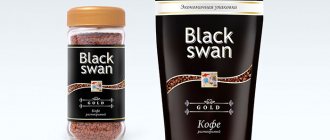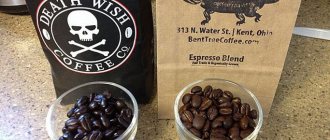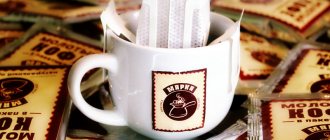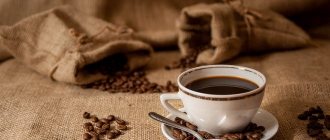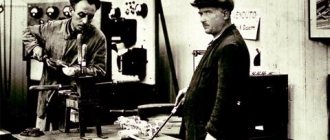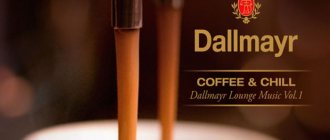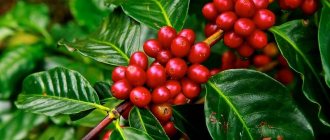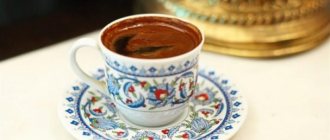Asian Luwak coffee is considered the most expensive due to the difficulty in obtaining the beans and the high quality of the finished drink. The grains must first pass through the digestive tract of palm martens, or musangs. The stomach juice of these mammals eliminates bitterness and contributes to the appearance of a chocolate flavor in the product.
Origin of Luwak coffee.
The Legend of Luwak and the History of the Origin of Coffee
Luwak production began in Sumatra. The colonialists imposed heavy taxes on coffee beans exported from the island. To avoid waste, local residents fed lemur-like animals, civets, with berries.
The grains then had to be washed out of their droppings. The taste of the drink changed. When producers noted this feature, a new variety was born, which quickly became expensive and elite.
According to legend, a peasant from the island of Sumatra was the first to extract grain from excrement. Palm martens, otherwise known as luwak, ate the entire coffee berry crop.
The peasant lived in poverty, so such an incident became a tragedy for him. He, however, noticed that the animals left behind feces in which whole coffee beans were visible. After thinking a little, the man began to remove the coffee from the excrement.
Producer followers
The island of Sumatra is not the only place where Luwak is produced. Suppliers of fermented grains also include Vietnam, the Philippines, and Indonesia. Production takes place in each palm civet habitat.
In Thailand, Black Tusk coffee is produced in a similar way. Instead of musangs, local residents feed the berries to elephants. To obtain a high quality drink, only Thai Arabica is used. The cost of a cup of coffee in some hotels is $50.
How coffee is made
The process of making the exotic drink Luwak, named after palm civets, includes several stages:
- Drying excrement. Feces are processed naturally, spread out on special sheets.
- Extraction. Farm employees extract coffee beans by hand. At the same stage, quality material is selected.
- Flushing. Selected grains are washed several times in water.
- Drying. The washed material is dried again in the open air.
- Roasting. Various varieties of Luwak have emerged through the use of several methods of roasting the beans. Each method gives the drink a special taste. The most common processing is using sweet syrup.
Characteristics of the drink
The drink made from grain that has passed through the stomach of an animal is very different from other types of coffee.
Taste characteristics
There is no bitterness characteristic of classic coffee, and there is no sourness either. The taste is soft, creamy chocolate. The drink smells like cocoa and caramel.
Differences from regular Arabica
Due to the peculiarities of obtaining raw materials, Luwak coffee has a lower strength than Arabica coffee. Its taste is less tart and has a greater number of shades. The cost of Luwak is several times higher than the price of Arabica. Because of this, the elite variety of coffee is even called the “drink of the gods.”
Effect on the human body
Thanks to the caffeine contained in coffee, activity increases and a person feels alert. Drinking 1 cup allows you to increase your performance by 10-12%.
Brain activity is stimulated. The weight loss process accelerates. Caffeine helps break down fat cells.
In addition, luwak eliminates cravings for high-calorie foods. The drink strengthens the immune system, prevents the development of inflammatory processes, and increases resistance to infections.
Coffee strengthens the immune system.
Looking for cheap flights?Looking for cheap flights?
Coffee is the most sold product after oil. There are coffee lovers in every home. Russia is among the top ten largest coffee lovers. Almost everyone loves coffee, but not everyone knows that the most expensive and most complex, elite and prestigious is Kopi Luwak coffee (coffee made from excrement). This is a unique variety of coffee No. 1.
Kopi Luwak coffee is the most expensive coffee made from animal excrement
Gourmets detect in it an unusually soft taste of caramel with the most delicate aroma of dark chocolate and vanilla with a persistent pleasant aftertaste. One cup of coffee can cost up to $90 in Europe. This probably adds a special charm to the excellent taste.
You can only try this extraordinary drink in expensive restaurants.
The technology of its preparation will shock anyone. Exclusive coffee for a narrow circle is obtained in the most extreme way - this coffee is not for the faint of heart. The method of making aromatic coffee differs from the traditional one. This unique, most expensive type of coffee is chosen from the droppings (excrement, in simple terms - ordinary poop) of animals.
Mussang is an animal with the kindest eyes, one of the producers of elite coffee
Soft to the touch and fluffy wild animals, distant relatives of the Rikki-Tikki-Tavi mongoose, resembling a cat with a big nose - the Asian palm civet (civet, luwak, musang or Chinese badger) are big fans of coffee berries. Moving from one tree to another, animals absorb the ripest and largest coffee berries in huge quantities.
This is how animals eat green coffee berries
Ripe coffee beans are red in color and resemble the fruits of a bay tree. During the day, one voracious animal can swallow up to 1 kg of coffee beans, from which only 50 grams of undigested coffee beans can then be picked out.
Appearance of coffee treated with animal gastric enzymes
Coffee beans treated with gastric juice enzymes and civet: - dried, cleaned and peeled, washed thoroughly, dried again, then lightly and carefully roasted at a certain temperature. The exact roasting recipe is kept secret.
Locals fry Kopi Luwak
Outlandish beans obtained in such an unusual way can only be obtained for 6 months of the year, and the rest of the time the animals do not produce the enzyme that gives coffee a unique aroma. Grains obtained from males have a greater and more pleasant aroma. A high standard is applied to defects in the appearance of coffee beans; the beans go through up to 15 degrees of sorting.
One of the stages of sorting coffee, the price of which is equal to the price of gold
The most expensive Kopi Luwak coffee with a unique aroma is produced in Indonesia in a special microclimate on the island of Java and earn huge money from it.
Luwak can also be purchased at the local market
Some researchers tried to get the same coffee in Ethiopia, simulating the natural process, since coffee trees grow there and civets live there. According to the tasters, Ethiopian coffee is inferior in taste to the original.
Ethiopian coffee is not much different in appearance from Indonesian coffee, but the taste is not the same
The most expensive coffee in Vietnam is called Chon, this is the most expensive and unusual coffee.
Expensive Vietnamese coffee Chon
The preparation technology is as complex as in Indonesia; coffee beans are used, processed by the stomach of an amazing animal. But the locals in Vietnam do not prepare coffee in a copper Turk or Jazz, but in a drip filter right above the cup.
Drip method of preparing Chon
The taste, aroma and thickness of coffee differs significantly from what Europeans are accustomed to. Vietnamese coffee is very thick, has a very rich aroma and a transparent dark color.
On the island of Bali, artificial small farms have been organized to produce delicacies for extreme sports enthusiasts. Luwak are kept in captivity, fed coffee berries and offer tourists a detailed look at the process of producing the most expensive coffee in the world, and if desired, even personally participate.
Tourists participate in the process of obtaining expensive coffee
All work has not yet been mechanized and is performed manually. Lovers of curiosities with lots of cabbage love show-offs. Most fans of the special aromatic Luwak coffee with a delicate caramel taste are in Japan.
Huge profits from the sale of “Luvak coffee” inspired the hardworking, enterprising Thais to organize coffee production using the stomach of elephants. Therefore, a farm-zoo was created in the north of Thailand. The stomachs of a herd of 20 elephants process coffee beans for the elite Black Ivory Coffee (Black Tusk or Black Ivory).
An interesting way to get elite coffee
The stomach of an elephant is many times larger than the stomach of the small predatory animal luwak (aka mussang). Coffee beans are kept in the elephant's stomach for more than a day, alongside a special diet of vegetables, bananas and sugar cane. During this time, coffee beans are saturated with fruit and vegetable aroma, processed by gastric juice, change their chemical composition and are naturally excreted, i.e. in the form of poop)
Thais mine unprocessed grains
Since elephants are vegetarians, extreme vegans should give a clear preference to Black Ivory over civet coffee. To get 1 kg of coffee, you need to feed the animal 33 kg of selected Thai Arabika beans, hand-picked on highland coffee plantations.
Local residents collect beans from coffee plantations
Veterinarians periodically check the level of caffeine in the elephant's blood. Therefore, the cost of coffee for the elite rises to $1,100 per kg. Exclusive coffee is offered only in expensive Anantare hotels in the Maldives and in the Golden Triangle Nature Reserve between Burma, Laos and Thailand. The cost of one cup of coffee is only $50. The new variety of exclusive, original coffee is sold in very limited quantities - only 60 kg were offered for sale last year. It took $300,000 to develop a new type of coffee.
In such an original way, you can drink a cup of delicious coffee in the Golden Triangle Nature Reserve.
Coffee lovers, having tried a new variety of coffee, Black Ivari, note the unusual taste, which is difficult to find epithets - it is a peculiar pleasant taste and an incomparable aroma.
This is the kind of pleasure you will get from a cup of properly brewed coffee.
In Russia, the first coffee house was opened in 1740 by order of Empress Anna Ioannovna. She was a big coffee lover. So Russian craftsmen should develop and put into production the production of coffee processed with Burenka. Its productivity with a constant appetite can compete with elephants, and the new coffee would be called Copi Burenka (or in our language: Burenka Coffee). And then you see, the name of the pioneer would be added to history, and even today the export of a new type of elite coffee would be added to the export of oil and gas.
If you, creaking your heart, gave your entire monthly salary as a teacher in Moscow for a package of coffee, then with bated breath, prepare yourself a cup, carefully preserving the foam while brewing, which from the first sip will fully reveal all the taste, divine aroma and make you want to drink everything to the end. Such delicacies greatly arouse curiosity, but sometimes reduce appetite, causing certain associations. For reference: Coffee from litter comes in different varieties. By far the most expensive is the original coffee made from Luwak dung, followed by coffee made from elephant dung. In third place is coffee made from monkeys!
Yes, yes, monkeys are sometimes useful too...
And now we are trying to guess who is in fourth place? Enterprising farmers from the city of Minneapolis (Minnesota) have started producing coffee from cat droppings. And according to its manufacturers, anyone who has not tried this coffee has not tasted coffee at all!
Did you like the article? Support AviaSovet.ru, click:
Nuances of production in different countries
The coffee production process differs depending on the country.
Indonesia
Indonesian farmers search the area early in the morning, before the sun has yet to warm the ground, to find the freshest wild animal droppings. Immediately after discovery, they contact the buyer, who inspects the excrement and determines whether the grain meets the standards.
Once the coffee arrives at the facility, it is immediately washed and the water is left for analysis to determine whether the feces came from a wild civet or a caged civet.
Vietnam
In Vietnam, the quality of luwak is worse than in Indonesia. Civets on farms are fed not only selected coffee berries. The animals' diet is very different from their natural diet, which affects the taste of the fermented grain.
In addition, under the guise of luwak, they often sell a mixture of coffee that has passed through the digestive system of musangs with robusta and arabica. The concentration of fermented grain can be 1-5% of the total mass.
Feeding animals.
Philippines
The production of luwak is carried out by the inhabitants of the southern part of the Philippines. Animals that eat coffee berries prefer to settle near the mountains. Local residents inspect the forest area every morning to find feces of wild civets.
The number of animals, however, is rapidly declining due to the use of civet produced by martens in perfumery.
Start of commercialization
One of the rules of marketing is the so-called ability to turn a disadvantage into an advantage. This is exactly what happened next.
Kopi Luwak quickly attracted the attention of the colony's administrators.
It was widely believed that the coffee tasted milder than regular coffee.
For the record, when someone uses adjectives like “smooth” or “strong” to describe coffee, it will most often be a sure sign that they don’t understand anything about it.
Due to the limited supply of Kopi Luwak, it could fetch more money when exported. Yet the coffee trade did not become a big business, and as large-scale commercial coffee production began to develop in regions other than Indonesia, interest in Kopi Luwak waned.
But then something big happened in 2007: Kopi Luwak was mentioned in the movie Before He Played It Off, starring Jack Nicholson and Morgan Freeman.
Interest in it has increased again, and resourceful entrepreneurs hastened to take advantage of this craze. Overnight, coffees with Kopi Luwak on the label began appearing in Southeast Asia, even though they were nowhere near cat droppings.
With good advertising, terrible Robusta can be sold for huge sums of money to some naive tourists who will believe that they bought the best coffee in the world.
But that wasn't the worst thing. It turns out that some farmers in poor Asian coffee-producing countries have suddenly started capturing martens and force-feeding them coffee berries.
Animals that ferment coffee
In addition to musangs, elephants can ferment coffee. The animals' diet includes vegetables, fruits, and sugar cane. Veterinarians ensure that the concentration of caffeine in the blood of animals does not exceed the norm.
Brazilians obtain fermented grains with the help of gray parrots. The birds' diet includes local fruits and nuts. Residents of South America prefer to create conditions close to natural for their parrots, so the taste and smell of coffee from the farm is almost no different from wild coffee.
Fermentation of grains can occur in the digestive system of some species of monkeys. Coffee varieties derived from primates are considered less elite than Luwak.
Processing disputes
At that time, the standards for harvesting and processing coffee beans were nowhere near what we have today.
When harvesting coffee, it is very important that the berries are completely ripe . As with other fruits, this ensures that your sugar levels reach their peak.
The animals prefer ripe berries, which suggests that in the wild the palm marten would be more selective than the workers of the Dutch plantations. But this is just a guess.
The process of processing coffee, at its core, is to remove the pulp from the berries before they begin to rot.
As a matter of fact, this happens in the animal’s stomach within 30 hours.
It is quite possible that this combination of careful selection of berries and efficient processing of coffee beans from the pulp made this coffee the best available at that time. However, it is worth remembering that the accepted processing standards back then could not compare with those now used by specialty coffee producers.
Varietal varieties
In addition to the classic Copi Luwak, gourmets can try other varieties of the expensive drink.
Black Ivory
Black tusk is processed in the stomachs of elephants. The cost of 1 kg of grain starts at $1,080, and for a cup you will have to pay at least $50.
This variety is not available for sale; it can only be purchased in the Anantara Nature Reserve. Only a few expensive Thai hotels offer the finished drink to guests.
Elite Black Ivory coffee.
Jacques Bird
This Brazilian variety is fermented in the digestive system of Gray parrots. The living conditions of birds on farms are as close to natural as possible; there are no cages.
Freshly roasted coffee is characterized by the aroma of dried black bread with notes of molasses. There is a fruity aftertaste. The price of 1 kg of coffee starts from $430.
Brazilian variety Jacquou Bird.
Coffee Terra Nera
Palm civets are used to produce this variety. Ready, freshly roasted coffee smells of hazelnuts and cocoa. Due to the small volume of production, the cost of the product increases to $1,500 per 1 kg.
The beans are sold only in a single coffee shop in London.
Luxury products are packaged in silver paper with a flap to preserve the aroma. The pack is supplied with a 24-karat gold tag, on which the client’s name can be engraved if desired.
Golden Coffee Terra Nera.
Why is Kopi Luwak so expensive?
Most people think that the high cost of Luwak coffee is only due to the fact that local farmers have to rummage through animal feces. This work is not the most pleasant, but the reason for the high price lies not there.
Farmers look for processed material exclusively in the excrement of wild animals, since musangs do not want to eat coffee beans, being unwitting. The secret of the high cost of the product is explained as follows:
- the most mature grains are collected exclusively by hand;
- two or three times a week the Luwak are given about 200 grams of coffee beans, on other days they are fed noodle soup and chicken, meat with rice, bananas and corn;
- animals are considered to be very selective, choosing exclusively ripe fruits;
- Musangs are regularly examined by a veterinarian, who carefully monitors their health.
Real Luwak coffee has a spicy taste with light notes of chocolate and caramel. The most expensive drink in the world costs about $600 per kilogram, the price for the most expensive Vietnamese version of coffee can reach up to $6,600 per kilogram.
Watch another video about musang.
Rules for preparing the drink
Recipes for making the drink differ depending on the country. Be sure to use purified cold water. Liquid at room temperature is not suitable, since the taste of the drink is not revealed when used. Do not cook luwak in hard tap water, replace it with filtered or bottled water.
With spices
Pour 1 clove star into the cezve, 5 pcs. cardamom, 0.5 tsp. ground ginger. Add 3 tsp. pre-ground coffee beans.
Pour 250 ml of cold water, then place the Turk over low heat. Wait until the foam rises, remove the cezve from the stove. Repeat twice more, then strain the drink.
Coffee with cardamom.
In Turk
Preheat the Turk. Then add 2 tsp. crushed grains, add 1-2 tsp if desired. granulated sugar. Warm the mixture slightly, then add cold water. Cook over low heat until foam rises. Then remove the Turk from the stove and pour the coffee into cups.
Flavored coffee.
In Vietnamese
To make Vietnamese coffee you will need a special filter press. Place the device over the cup, fill 2-3 tsp. ground coffee.
The coffee powder is compacted and then poured with a portion of water. After 0.5 minutes, add a little more liquid. Then they wait until the water has completely flowed into the cup and drink immediately. To get warm coffee, it is recommended to first place the mug in a container of hot water.
Vietnamese coffee.
Where to buy in Vietnam?
Buying coffee in Vietnam is not difficult, since it is the favorite drink of the local population and tourists. As in many other resort towns, coffee in Nha Trang is sold in small shops, as well as in specialized stores. And the assortment is amazing. Different varieties, ground and beans - choose to your taste. Almost everywhere, when you buy coffee beans in bulk, if you wish, they will grind it right in front of you and then beautifully package it. Moreover, you can not only enthusiastically inhale the alluring aroma of coffee, but also arrange a real tasting right on the spot. And without any fear that the purchased variety will not be to your taste. Try first, buy later! You can also buy coffee in supermarkets, but, as a rule, the choice there is not very rich.
Read more about shopping in our articles:
- Shopping centers in Nha Trang;
- Markets of Nha Trang.
Criterias of choice
When choosing grains, consider a number of criteria:
- There should be no glossy shine. This feature indicates roasting using palm oil. Sometimes shine occurs due to too rapid heat treatment. This is beneficial for the manufacturer because it saves time. The taste of the product, however, deteriorates.
- Take a closer look at the grains. The packaging must not be broken or damaged. If the grains of one blend differ in size, it is better to refrain from purchasing.
- A price that is too low indicates a fake. Luwak coffee costs from $200 per 100 g; it is not profitable for the manufacturer to sell the product cheaper.
- Flavorings are not allowed. Their use indicates low grain quality.
A little more history
To understand how things are going with coffee production in Vietnam, including Luwak coffee, it is worth considering some facts.
- Tales about the centuries-old history of coffee production in Vietnam are a myth. The first plantations in the country appeared only in the middle of the 19th century. thanks to the colonialists from France.
- If coffee production was introduced recently, then the culture of drinking the drink by local residents is very young and unique. For the Vietnamese, it is important that coffee is invigorating and sweet. Preferably with ice.
- The development of the country as a whole, and coffee production in particular, was significantly influenced by the Vietnam War. The agricultural industry at that time stopped developing. Vietnam was not able to buy advanced technologies, and there was no time for them.
- Coffee production has developed rapidly only in the last few decades. And this development is aimed mainly at a significant increase in quantitative turnover. Most of the coffee from Vietnam is exported.
A unique Vietnamese system for brewing an invigorating drink
What causes the high cost of Luwak coffee?
The cost of production is high for 3 reasons:
- Small production volume. The mass of grains in the feces of the palm marten is small. Making “wild” coffee is further complicated by the need to search for excrement in the forests where the musangs live.
- Palm civets produce civetin, a substance necessary for processing grains in the digestive tract, for only 6 months of the year. At other times, the farms are idle and no drink is produced. Often animals are released into the wild during this period so as not to spend money on their maintenance.
- Musangs do not breed in captivity, so farmers have to regularly catch new individuals in the forests.
Musangs do not have offspring in captivity.
The process of making the world's most expensive coffee: the secret is in the intestines
Kopi Luwak or musang (palm marten) is a story in Southeast Asia. The peculiarity of this animal lies in the ability of gastric juice to break down proteins and give the future drink a special taste with a hint of bitterness. The animal literally shits the finished product.
The coffee beans pass through the Luwak's digestive tract and stomach virtually intact. The secret that musang holds is the fermentation process, during which a certain amount of grains is digested and not only the taste, but also the aroma of the product obtained from animal feces is enhanced.
Interesting Facts
The legend about the origin of this type of coffee is funny and educational, but there are many more interesting facts about this extraordinary drink:
- Kopi Luwak is often criticized by environmentalists. Coffee berries are not the basis of the diet of martens; excess caffeine has a negative effect on the animal’s body. In addition, on farms the animal is often kept in poor conditions.
- In captivity, the musang eats approximately 1 kg of berries daily. A daily portion of excrement contains no more than 60-70 g of grains.
- Every year, only about 300 kg of Kopi Luwak enters the world market. Most lovers of expensive coffee are in the UK, Hong Kong, and Japan.
- In Vietnam, luwak is traditionally served over ice. If desired, condensed milk can be added to the drink. Additionally, a cup of green tea is served.
Where are the coffee plantations?
In addition to Indonesia, Bali and Vietnam, plantations are found in the Philippines. The farms are located in the southern part of the state, where the musangs live. But in the Philippines, coffee production is gradually disappearing due to the decline in the number of civet cats. Animals are exterminated by perfume companies.
Who is the main producer
The main producer of the exotic variety of drink Luwak is considered to be the civet cats themselves. The taste of the final product often depends on the characteristics of the body of a particular animal. The actions of employees of companies involved in packaging beans have almost no effect on the taste of coffee.
View this post on Instagram
Publication from
